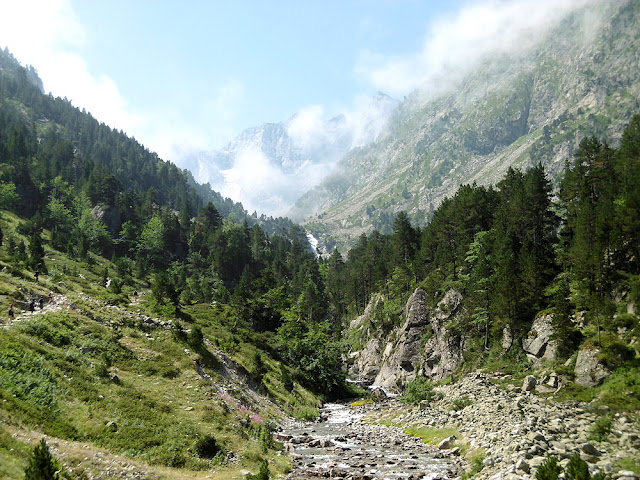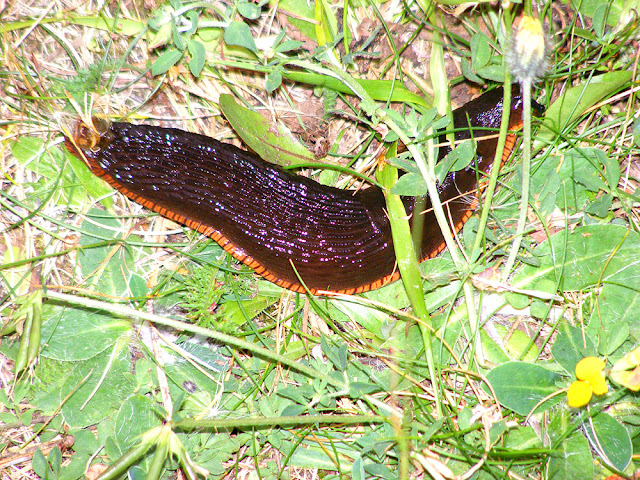Cauterets is a small 19th century spa town in the Hautes-Pyrénées mountains, south of Lourdes and close to the Spanish border. After the Second World War the town transformed itself into a ski resort. Nowadays it is extremely popular with families who like outdoor pursuits in the summer.
 |
| View from the Cretes du Lys 1850 metres above sea level, with Cauterets obscured in the valley below. |
Mountains: The nearby Vignemale is the highest peak in the French Pyrénées at 3298 metres above sea level. There is mixed forest, many streams and waterfalls, alpine meadows grazed by cattle, sheep and horses. Much of the area is national park. In some places there is mining for slate and minerals, and nearby valleys have been dammed for hydroelectric schemes.
 |
| The glacier on the north face of Vignemale and the Oulettes de Gaube refuge (2151 metres above sea level). |
Hiking: There are lots of hiking trails of varying difficulty. The easiest we did was 6 km return on a gentle gradient through the forest with a path that was level under foot. We did that on our rest day, 3 km up hill to a nice restaurant at La Railliere, then 3 km down hill back to Cauterets after lunch. The two really challenging walks we did were both to mountain refuges and back, totalling 16 and 18 kilometres respectively. They were both longer than we had read they were, and more difficult in terms of the terrain underfoot, with a lot of rockhopping. We drove to suitable start points, and in one case, used the chairlift to dodge a very steep section. Our approach was to aim for refuges for lunch and to replenish water supplies, as it was very hot, even above 2000 metres. However, that does mean you must commit to walking at a pace that will get you to your destination by a certain time range. It meant not being able to stop and look at things very much. On one walk we missed the last chairlift and had to walk down an extra 4 kilometres. Luckily summer days are long. You need good hiking boots and I would recommend poles for many of the walks. In summer you need to be able to carry a minimum of a litre and a half of water per person for the way up plus replenish it at a refuge before descending. The weather can change very quickly in the mountains, and on one of our walks the fog rolled in for the return, so you should carry a waterproof jacket or cape.
 |
| View up one of the valleys we hiked. |
Wildlife: The highlight species are Griffon Vultures and Alpine Marmots, which most people get to see. Then there are rare alpine species such as Isards (Pyrenean chamois), which we never saw, but the German couple a few minutes behind us on the trail did -- grazing amongst the cattle. I was so pissed off! Alpine flora and butterfly species are always challenging and lovely, and I'm sure serious birdwatchers enjoy the area for the many endemic species.
 |
| Griffon Vulture (Fr. Vautour fauve) overhead. |
History: There are many interesting medieval churches and villages in the hills and valleys around Cauterets. In the 17th century the area was rich from mining, but by the 19th century the land had been over exploited, with deforestation and overgrazing causing landslides and the economy ruined. Luckily, Prosper Demontzey arrived to be the Government Superintendant of Water and Forests and initiated a programme of habitat reconstruction which employed local people to restore and stabilise the landscape. The Romantics arrived at the beginning of the 19th century to be awed by the sublime views and from the 18th century the rich had been coming to take the cure at the thermal spas. After the two World Wars in the first half of the 20th century the economy collapsed and the area was threatened with big public works projects such as hydroelectric dams. The community in Cauterets fought to get their area declared as a national park, for the valleys not to be dammed, and little by little installed the infrastructure for skiing. This transformation into a winter sports destination successfully revitalised the economy.
 |
| The mysterious fortified church in Luz Saint-Saveur. Personally, I suspect that some 19th century nutter that everyone has forgotten is responsible. |
Food: We ate twice at mountain refuges, where you get simple food such as a rice salad, omlettes, tomatoes, charcuterie and cheese. At some refuges you need to order your meal online and get there between 12pm and 3pm, at others you can just turn up and they will feed you. They only take cash and a meal will cost about €10, soft drinks and cakes extra. You are asked to take your own rubbish with you as everything is helicoptered in and out. We also had blanquette de veau (veal stew) at a ski station, which is basically pub grub. Veal is currently being promoted as a quality local product. Several times we bought salad items at the supermarket (Carrefour) and picnicked.
 |
| Charcuterie platter at the Refuge d'Estom, 1801 metres above sea level. |
Brasserie de Bigorre - in Cauterets, where we had dinner and ate locally produced smoked trout, mountain lamb and moelleux de chocolat (squidgy chocolate cake). Booking essential. https://www.tripadvisor.com/Restaurant_Review-g196622-d2251303-Reviews-La_Brasserie_de_Bigorre-Cauterets_Hautes_Pyrenees_Occitanie.html
 |
| Female Black-striped Longhorn beetle Stenurella melanura (Fr. Lepture à poils durs) and a Piedmont Ringlet E. meolans (Fr. le Moiré des fétuques) on Eryngium bourgatii. |
L'Abri du Benques - up the hill a couple of kilometres from Cauterets at a hamlet called La Railliere. The restaurant sits right by a waterfall and serves a daily changing three course set menu. The day we lunched there it was garbure (a very traditional regional soup with white beans, root vegetables and meats), locally raised trout, and blueberry melba (lime and blackcurrant sorbets with stewed blueberries). http://www.benques.com/
 |
| Locally farmed trout served for lunch at L'Abri du Benques restaurant in the hamlet of La Railliere. |
Many menus feature local lamb, veal, trout, charcuterie, cheese and blueberries (Fr. myrtilles).
Dinner is surprisingly early in Cauterets, possibly because there are so many families staying there. If you are not seated at a table by 7pm or have a booking, you may have to go further afield.
 |
| The Lutour valley looking towards Estom. |
How we got there: We drove our own car. Once there we parked in the free parking near the station as our accommodation did not have parking.
 |
| A Large Red Slug Arion rufus (Fr. la Grande loche) in a colour morph I've never seen before, at about 1700 metres above sea level. |
Where we stayed: A one bedroom first floor apartment in an old residence in the centre of the village, a block from the town hall, owned by famous mountain guide Jean-Louis Lechene, who lives on the top floor. Plenty of space, well equipped kitchen, excellent bathroom.
 |
| The view from our apartment balcony. |
Conclusion: You could easily arrive in Cauterets in the summer, unload the car, park it, and never use it again until you left a week later. There is easily enough to do with all the hiking and other outdoor activities accessible from the town (cycling, rafting, fishing), as well as the spas, swimming pool, national park museum, games arcade, free street concerts and restaurants.

No comments:
Post a Comment